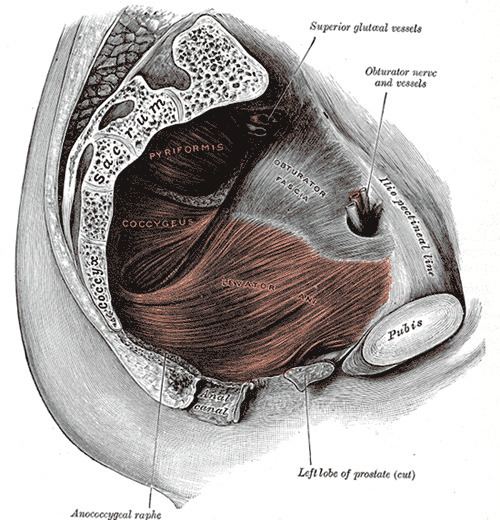Latin Musculus levator ani | ||
 | ||
Insertion Inner surface of coccyx, levator ani of opposite side, and into structures that penetrate it. Nerve pubococcygeus and iliococcygeus:levator ani nerve (S4)inferior rectal nerve from pudendal nerve (S3, S4)coccygeal plexuspuborectalis:S3, S4.levator ani nerve Actions Supports the viscera in pelvic cavity | ||
The levator ani is a broad, thin muscle, situated on either side of the pelvis. It is formed from three muscle components: the puborectalis, the pubococcygeus muscle (which includes the puborectalis) and the iliococcygeus muscle.
Contents
It is attached to the inner surface of each side of the lesser pelvis, and these unite to form the greater part of the pelvic floor. The coccygeus muscle completes the pelvic floor which is also called the pelvic diaphragm.
It supports the viscera in the pelvic cavity, and surrounds the various structures that pass through it.
The levator ani is the main pelvic floor muscle and contracts rhythmically during orgasm.
Structure
The levator ani is divided into three parts:
The iliococcygeus arises from the inner side of the ischium (the lower and back part of the hip bone) and from the posterior part of the tendinous arch of the obturator fascia, and is attached to the coccyx and anococcygeal body; it is usually thin, and may be absent, or be largely replaced by fibrous tissue. An accessory slip at its posterior part is sometimes named the iliosacralis.
The pubococcygeus muscle is then divided into three parts on its own.
Origin and insertion
The levator ani arises, in front, from the posterior surface of the superior pubic ramus lateral to the symphysis; behind, from the inner surface of the spine of the ischium; and between these two points, from the obturator fascia.
Posteriorly, this fascial origin corresponds, more or less closely, with the tendinous arch of the pelvic fascia, but in front, the muscle arises from the fascia at a varying distance above the arch, in some cases reaching nearly as high as the canal for the obturator vessels and nerve.
The fibers pass downward and backward to the middle line of the floor of the pelvis; the most posterior are inserted into the side of the last two segments of the coccyx; those placed more anteriorly unite with the muscle of the opposite side, in a median fibrous ridge called the anococcygeal body or raphe, which extends between the coccyx and the margin of the anus.
The middle fibers are inserted into the side of the rectum, blending with the fibers of the Sphincter muscles; lastly in the male, the anterior fibers descend upon the side of the prostate to unite beneath it with the muscle of the opposite side, joining with the fibers of the external anal sphincter and transverse perineal muscles, at the central tendinous point of the perineum.
The anterior portion is occasionally separated from the rest of the muscle by connective tissue.
From this circumstance, as well as from its peculiar relation with the prostate, which it supports as in a sling, it has been described as a distinct muscle, under the name of levator prostatæ.
In the female the anterior fibers of the levator ani descend upon the side of the vagina.
Innervation
The levator ani muscles are mostly innervated by the pudendal nerve, perineal nerve and inferior rectal nerve acting together.
Variation
In addition, sacral spinal nerves (S3, S4) innervate the muscles directly as well (in ~70% of people). Sometimes (in ~40% of people) the inferior rectal nerve innervates the levator ani muscles independently of the pudendal nerve.
Function
The levator ani muscles are responsible for "wagging" the tail in tailed quadrupeds. These muscles are not as strong in the human, as tail-wagging is more demanding than the support function that the muscles serve in humans.
Levator ani syndrome
Levator ani syndrome (also called levator spasm, puborectalis syndrome, chronic proctalgia, piriformis syndrome, pelvic tension myalgia, levator syndrome, and proctodynia) is episodic rectal pain that can waken the patient from sleep, caused by spasm of the levator ani muscle. The etiology is unknown, however it has been suggested that inflammation of the arcus tendon is the possible cause of levator ani syndrome
Symptoms include a dull ache to the left 2 inches above the Anus or higher in the rectum and a feeling of constant rectal pressure or burning. The pain may also be felt in the low pelvis or perineum.
The discomfort may be relieved by walking or pelvic tightening exercises similar to Kegel exercises. Other treatments include massage of the muscle, warm baths, muscle relaxant medications, therapeutic ultrasound and biofeedback. Electrical stimulation of the levator ani muscle has been used to try to break the spastic cycle. Injection of botulinum toxin A has also been used.
Variants of levator ani syndrome include proctalgia fugax (fleeting pain in the rectum) and coccydynia (pain in the coccygeal region). Proctalgia fugax and levator ani syndrome have not been found to be of psychosomatic origin, although stressful events may trigger attacks. Patients with levator ani syndrome also have "significant elevations on the hypochondriasis, depression, and hysteria scales of the Minnesota Multiphasic Personality Inventory," which is also the case in general among chronic pain sufferers.
